1895: Original
Holley Carburetor Factory
Part of the Bovaird and Seyfang Building
24-34
Davis St. Bradford, PA
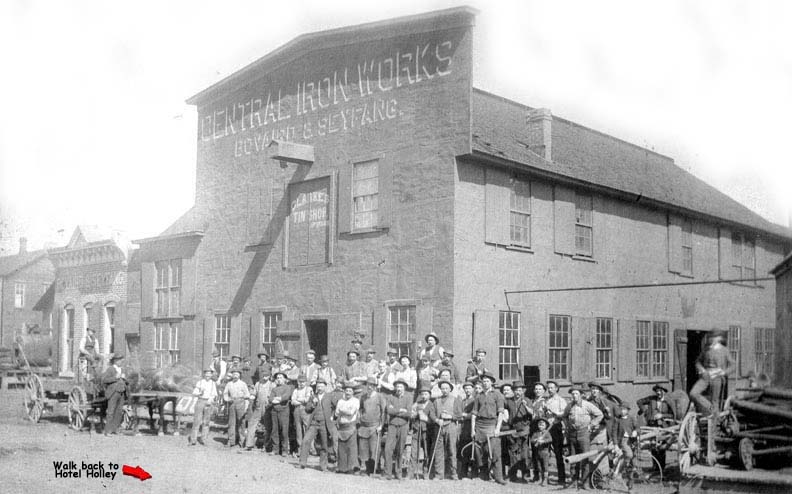
Photo Credit: Bradford Landmark Society Archives
Go to the Holley Carborator
Company's webpage
Read articles about George Holley:
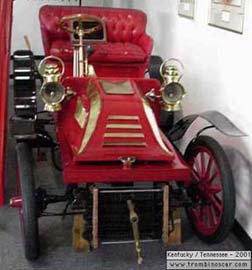 The
exact origins of the original Holley factory are rather unclear. One paper says
that George Holley's workshop was located "across the street" from
the Holley Hotel in the Bovaird & Seyfang Building. However the B&S
Building takes up an entire city block. We are unsure where exactly in this
building George Holley's workshop was. This photograph is part of the building
during the time period that George Holley would have been working inside.
The
exact origins of the original Holley factory are rather unclear. One paper says
that George Holley's workshop was located "across the street" from
the Holley Hotel in the Bovaird & Seyfang Building. However the B&S
Building takes up an entire city block. We are unsure where exactly in this
building George Holley's workshop was. This photograph is part of the building
during the time period that George Holley would have been working inside. 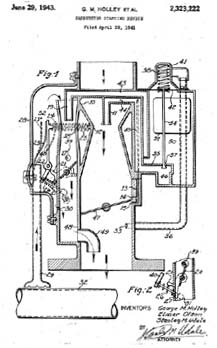
It does however make sense that Holley would be working
in this building because his good friend J. E. Cochran was the President and
General Manager of the Bovaird and Seyfang Manufacturing Company. Mr. Cochran
hleped finance the original automotive.
George Holley was 19 when he designed
and built a three-wheeled single-cylinder buggy which hit an impressive speed
of 30 miles per hour in 1897. The car weighed 306 pounds, had a 60-inch wheelbase
and a two-cylinder, nine-horse-power engine with 2 speeds forward and no reverse.
Later on, George and his brother,
Earl, decided to form a company to manufacture motorcycle engines and motorcycles
in Bradford, Pa. George became the chairman of the board along with engineer
and salesman. Earl handled the business and finance part of the company as the
president since he was once a bank teller.
In 1901, after a visit to Paris, France, the Holley brothers obtained a license
to produce and sell the French Longuemare Carburator in the United States, also
known as the "iron pot." That same year, George built his first motorbicycle
that ran about 25 mph.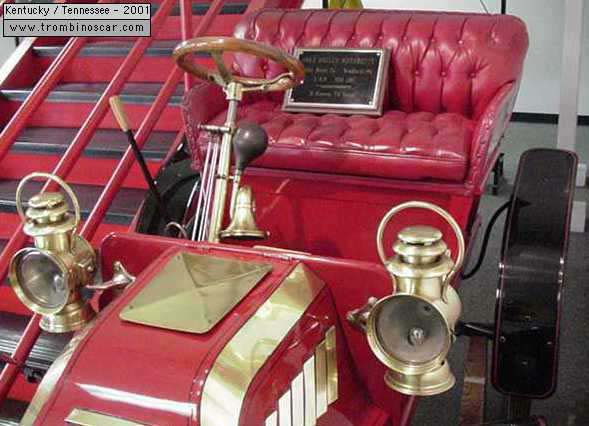
George enjoyed racing and in 1902,
he won a motorycle endurance contest from Boston to New York and set world speed
records at the Pan American races too. Read
more about George Holley's motorcyle and races.
In 1903, Henry Ford asked George Holley to make a carburetor
for the Model T. This is how George recalls his meeting with Henry Ford. “I
first met Mr. Henry Ford, Sr., early in 1903. The Ford Motor Company wired asking
me to come to Detroit. I went out to the Ford Motor company, on Kercheval Avenue,
which was then an old frame building belonging to Mr. Malcomson, and had been
used as a coal yard. I found Mr. Ford with Mr. C.H. Wills, sitting in the pattern
shop on a bench, and they told me that they would like to have me design a carburetor
for their new car. As I remember it, they were not actually in production, but
were getting ready; and at that time, Dodge Brothers were turning out the chassis,
and they were putting on the wheels and the body, assembling the car, and setting
it up. Mr. J.C. Couzens was the only man who had a office which was located
out front on the second floor. I was to go back to Bradford, Pennsylvania, and
design this new carburetor for them. The Model A carburetor I designed and brought
back to Mr. Ford has a threaded outlet instead of a flange. Through the years
we produced many different carburetors and ignition devices for Mr. Ford and
Ford Motor Company.”
Because the Holley brothers sensed a trend in industrial
specialization, they decided to concentrate on designing and building carburetors
and ignition-system components for car makers such as Pierce-Arrow, Winston,
Buick, and Ford. George and Earl along with George Welch decided to incoporate
under the name of “Holley Brothers Company.
In 1904, their original “iron pot” carburetor
was introduced for application on Oldsmobile and Ford Motor Cars.
In 1907, George and Earl Holley moved their company to Detriot
and later supported the war effort by producing automotive, marine, and aviationary
units.
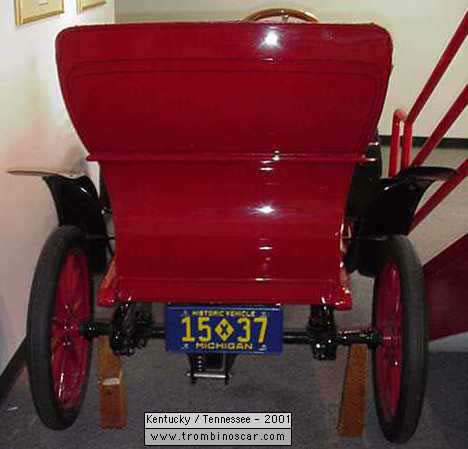
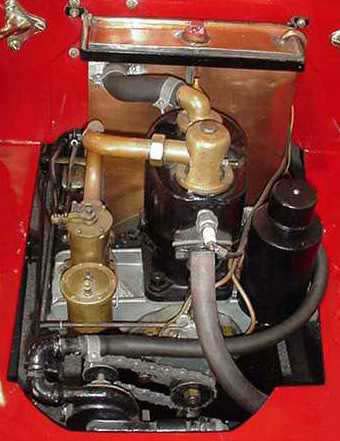
Photo Credit for all "Runabout" Photos: www.trombinscar.com
Return to Top
The only drawing that a accompanied a Holley Chassis, the
rest was left to the imagination of the buyer.
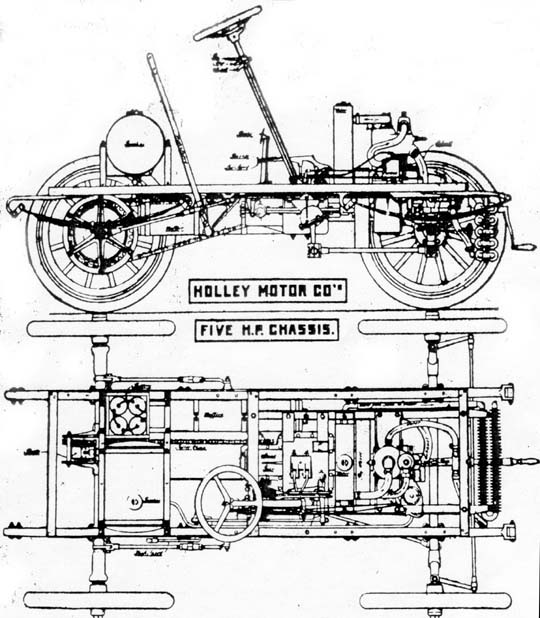
As can be imagined, assembling the chassis was a slow
and laborious process, even with the aid of the solitary blue print supplied.
The angle iron frame was drilled for spring hangers, shackle brakets, radius
rod anchors, engine, transmission and all other component parts, witha hand
operated thrust drill.
Return to Top
GEORGE
HOLLEY, FORMER LOCAL RESIDENT, NAMED TO HALL OF FAME OF AUTOMOTIVE INDUSTRY
The Era, Bradford, PA,
Saturday May 4, 1946
George Holley, a former resident of Bradford,
will be one of ten persons, pioneers of the motor industry, who have been
selected for the Automotive Hall of Fame by the Automotive Manufacturers
Association and the National Automotive Golden Jubilee Committee, according
to announcement by Lt. Gen. William S. Knudsen, chairman of the industry
committee for the celebration.
Marketed Carburetors
Mr. Holley is the son of the late Frank Holley who built and for many
years conducted the Holley hotel here. Shortly after the turn of the century
George and his brother Earl, left Bradford and went to Detroit where they
manufactured the Holley carburetor which was used in the Fords and other
makes of cars.
Before leaving for Detroit, George Holley built an automobile in the basement
of the hotel and later put the vehicle on the market. The car, remembered
for its oddity, was a three-wheel affair, one in front and two in the
rear.
The car was built at Holley Motor Works now the site of Bradford Motor
Works. The Holley brothers also were among the first to go into the motor
bike industry in the United States and their product sold extensively.
Other Pioneers Named
During the Pan-American Exposition in Buffalo in the early 1900’s,
George Holley took the bike to Buffalo and set numerous records for two-wheel
vehicles.
After moving to Detroit the two brothers invented a carburetor and George
proceeded to make one which proved a success and also marked the rise
in the industry of the Holley Carburetor Company in the Motor City.
The men who will be honored during the Automotive Golden Jubilee, May
29 to June 9, besides Mr. Holley, will be Edgar Apperson, pioneer builder
and designer; William C. Durant, automotive empire builder; J. Frank Duryea,
surviving member of the Duryea Brothers, makers of early gasoline motor
wagons; Henry Ford, father of the assembly line; Charles B. King, who
built and drove the first car in Detroit; Charles W. Nash, who headed
some of the industry’s largest companies; Barney Oldfield, speed
driver; Ransom E. Olds, pioneer of mass production, and Alfred P. Sloan
Jr., pioneer maker of auto parts.
|
Return to Top
Holley: A Century
of Automotive Performance Progress
National Dragster Magazine
December 3, 2003
With a 100-year heritage of automotive history and
a half century as a major corporation in Bowling Green, Ky., it was only
natural that Holley was the enthusiastic sponsor of this year's inaugural
Holley NHRA National Hot Rod Reunion presented by DuPont Automotive Finishes
in Bowling Green. Holley has enjoyed decades of woking with NHRA and the
sport's many hot rodding fans to further the advancement of high-performance
drag racing.
It all began in Bradford, Pa., in 1896 when brothers George and Earl Holley
took and intense interest in motorcyle racing and buldt a three-wheel
vehicle powered by a single-cylinder engine. The vehicle was able to reach
impressive speeds of 30 mph to earn its nickname, "the Runabout."
After a visit to Paris in 1901, the Holley brothers (now the Holley Motor
Co.) obtained a license to produce and sell the Fench Longuemare carburetor
in the United States. This decision redircted their focus toward the emerging
automotive industry, and in 1903, the brothers began producing a car called
the Holley Motorette, of which more than 600 were sold.
The business was incorporated under the name Holley Brothers Co., and
its first original carburetor, called the iron pot, debuted in 1904. Designed
for application on the curved-dash Oldsmobile, it later became standeard
equipment on Ford vehicles as well.
The first Holley plant in Detroit opened in 1907, and following additional
growth brought on by the burgeoning car industry and diversified industrial
production as a result of World War I, the name of the business was changed
to Holley Carburetor Co. in January 1918.
After developing carburetors used by such venerable names as Curtiss-Wright,
American Airlines, Pan American Airlines, and the U.S. armed forces, Holley
produced approximately half of all the military carburetors used in World
War II.
Holley entered the automotive aftermarket in 1948, supplying carburetor
repair kits and genuine Holley parts to garages and service stations.
In 1952, a new 250,000-square-foot manufacturing plant was opened in Bowling
Green, and product development continued with the first Holley modular
carburetor, the mode 4150 that was made standard on the '57 Ford Thunderbird.
After a merger with Colt Industries in 1968, the Holley Replacement Parts
Division was formed in 1979 to offer such parts as electrical and ignition
components, intake manifolds, fuel pumps, and Mickey Thompson performance
products, later followed by fuel-injection systems. In the early 1980s,
a carburetor remanufacturing plant was opened in Springfield, Tenn.
When the Holley original-equipment division was purchased bu Borg-Warmer
in 1994, Holley Replacement Parts was relocated to Bowling Green and the
company name was changed to Holley Performance Products.
In May 1998, the senior management team purchased Holley from Coltec Industries
Inc.; the transaction involved the acquisition of the administrative office
building, manufacturing plant, distribution center, and the Springfield
remanufacturing facilty. Holley enacted plans to became a larger, more
aggressive company with several strategically important company buyouts
that included Hirel Technologies Fuel Injections, Weiand Automotive Industries,
Lunati, Hooker Headers, Flow Tech and Amass exhaust products, NOS nitrous
systems, and Earl's plumbing.
To support this broad ranged of performance and remanufactured products,
Holley employs approcimately 475 people at its world headquarters and
manufacturing complex in Bowling Green. Holley has long been an NHR major
sponsor and has a major presence along the Manufacturers Midway at NHRA
national events.
Having recently celebrated its 50th anniversary as a major employer in
Bowling Green, Holley takes its corporate responsibility seriosly and
donates thousands of dolars yearly to such causes as the American Cancer
Society's Relay for Life, Special Olympics, Pregnancy Support Center,
United Way, the fight against multiple sclerosis, and a multitude of local
charity organizations.
With its 100 years of manufacturing heritage, Holley is stronger than
ever in product offering, engineering capability, marketing expertise,
and manufacturing efficiency, and its modern distribution facilty can
support continued growth. Holley enters the 21st century as an aftermarket
performance industry leader with excellent future prospects, and the city
and citizens of Bowling Green will be the primary beneficiaries of Holley's
future growth.
|
Return to Top
George
Holley, Bradford Automotive Pioneer Is Dead
McKean County Democrat
Thursday July 4,1963
DETROIT- Funeral services were held Monday at Grosse Point Mich., Memorial
Church, for
George Malvin Holley, pioneer automotive engineer who built his first
car in Bradford, Pa., and later developed the "iron pot" carburetor
for the first Model T. Ford. He died Thursday at a local hospital at the
age of 85.
He was chairman of the board of the Holley Carburetor Co., and bearing
his name in Bradford is the Holley Hotel and Holley Ave. in East Bradford,
believed to be the site of one of his first plants. A native of Port Jervis,
N.Y., Mr. Holley's family came to Bradford in the late 19th century. His
father owned the Riddell House in that city, which later became the Holley
Hotel.
George Holley established the Holley Motor Co. about 1900 for the manufacture
of a motorcycle known as "Autobike." His first motor car developed
in Bradford was an experimental three-wheeler which did 30 miles an hour.
Mr. Holley resided in the Detroit suburb of Grosse Point for many years,
and was awarded the Charles Clifton trophy as a pioneer manufacturer of
auto accessories. In 1902, Mr. Holley and his late brother, Earl, put
out their first marketable automobile, The Motorette, which sold for $550.
They built more than 600 vehicles in Detroit. In the same year, they were
approached by Henry Ford about making a carburetor for the Model T, and
the "iron pot" resulted, leading to a succession of carburetor
and ignition devices designated and built by the Holley brothers for the
Ford Motor Co.
They opened their Detroit plant in 1907 and also manufactured carburetors
for E. R. Thomas, Pierce Arrow, Winton, Oldsmobile and Buick. Later, the
firm entered the aviation field and in 1935 developed the carburetor that
overcame icing. During Its history, the Holley Carburetor Co. has produced
more than 15 million units for automotive, aviation and marine use.
Surviving are his widow, the former Margery Corliss; a daughter, Mrs.
Philip Gregg Kuhen of Milwaukee; two sons, George M. Holley Jr., of Detroit
and John
Holley of Chicago, and 11 grandchildren.
|
Back to Top
Today ~ 2008
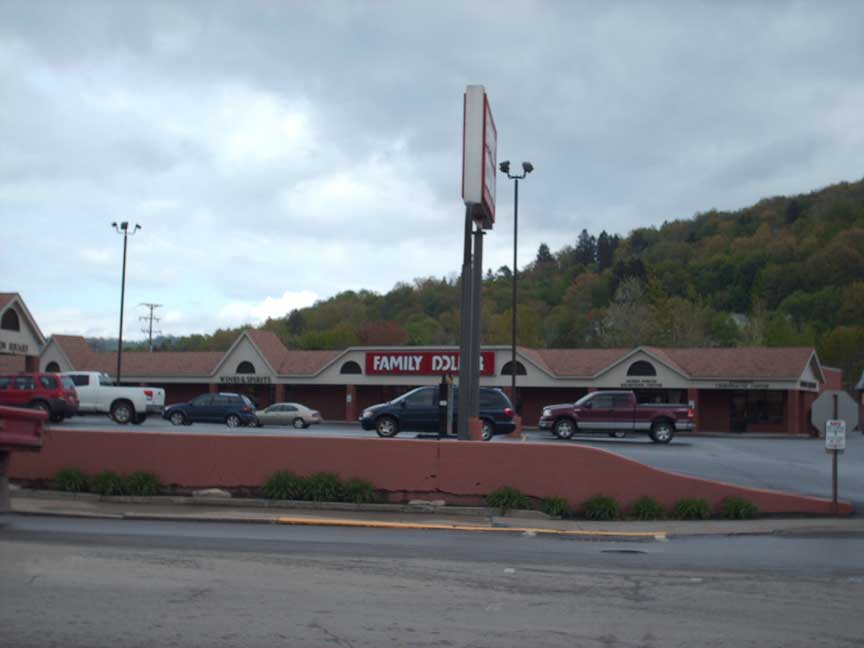
photo credit: Brittany Gorrell
Special thanks to the Bradford Landmark Society, the
Bradford Public Library, and Mary Pierotti for all their time and hard work.


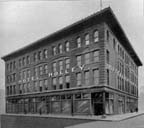



 The
exact origins of the original Holley factory are rather unclear. One paper says
that George Holley's workshop was located "across the street" from
the Holley Hotel in the Bovaird & Seyfang Building. However the B&S
Building takes up an entire city block. We are unsure where exactly in this
building George Holley's workshop was. This photograph is part of the building
during the time period that George Holley would have been working inside.
The
exact origins of the original Holley factory are rather unclear. One paper says
that George Holley's workshop was located "across the street" from
the Holley Hotel in the Bovaird & Seyfang Building. However the B&S
Building takes up an entire city block. We are unsure where exactly in this
building George Holley's workshop was. This photograph is part of the building
during the time period that George Holley would have been working inside. 




